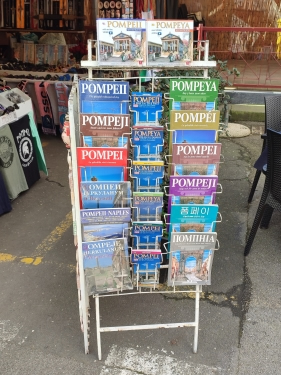(Page 3 of 5 / Links to other pages at end of this page)
Day 3 – Pompeii
Day 3 was entirely dedicated to Pompeii. The visit began with a guided-tour, to ensure we didn’t miss any “must-sees” during our time at this expansive archaeological site, followed by a look inside the museum and a walk across the entire site to see the amphitheatre, which is at the opposite end from the main entrance and beyond the scope of the more popular walking tours.
Pompeii: A Window into Ancient Roman Life
Nestled in the shadow of Mount Vesuvius, Pompeii stands as a testament to the grandeur and tragedy of the Roman Empire. This ancient city, once bustling with life, was frozen in time by the catastrophic eruption of Vesuvius in 79 AD. Today, it offers an unparalleled glimpse into the past, its streets and buildings preserved under layers of volcanic ash.

The city of Pompeii was more than just a settlement; it was a vibrant community with a complex social structure, thriving economy, and rich cultural life. The ruins reveal grand public buildings such as the forum and amphitheatre, alongside lavish villas and simpler homes, hinting at the diverse social fabric of the city. Artifacts like frescoes, mosaics, and everyday objects paint a vivid picture of daily life, from the luxurious banquets of the wealthy to the bustling activity of the marketplaces.

Pompeii's preservation provides a unique opportunity for archaeologists and historians to study the Roman world. The ash that entombed the city also protected it from the ravages of time, allowing us to walk the same streets as the ancient Pompeiians. It's a place where history is tangible, where one can almost hear the echoes of Roman merchants, artisans, and families that once called this city home.

Designated a World Heritage site in 1997, Pompeii continues to captivate and educate, drawing millions of visitors each year. It serves as a poignant reminder of nature's power and the enduring legacy of the Roman civilization. For those looking to connect with the ancient Roman world, Pompeii is a destination without parallel.
The Guided Tour
Each site tells a story of the city's rich history and the daily lives of its inhabitants, making Pompeii an invaluable archaeological treasure. Whether it's the grandeur of the temples, the hustle of the market, or the intimacy of a private home, Pompeii continues to captivate and educate the world. Some of the main sites seen during our guided tour are as follows:
Terme Suburbane (The Suburban Baths). These baths, located near the Porta Marina, were built in the early Imperial period and are known for their luxurious design and erotic wall paintings. They were a place of socialization and relaxation, featuring a complex system of heated rooms and pools:


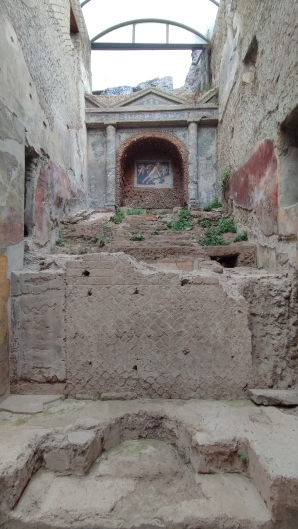 |
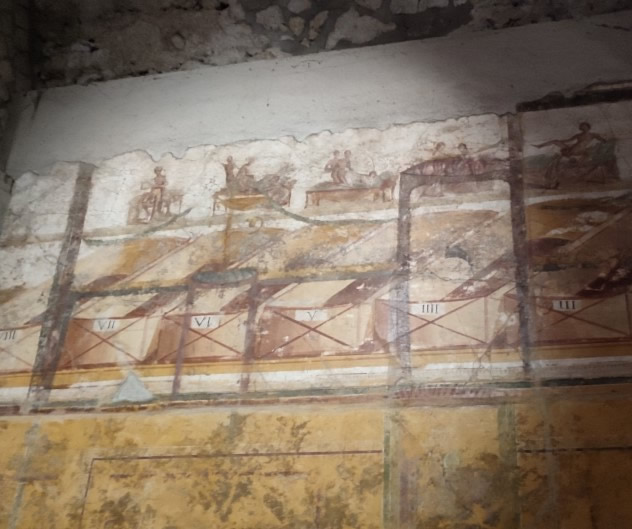 |
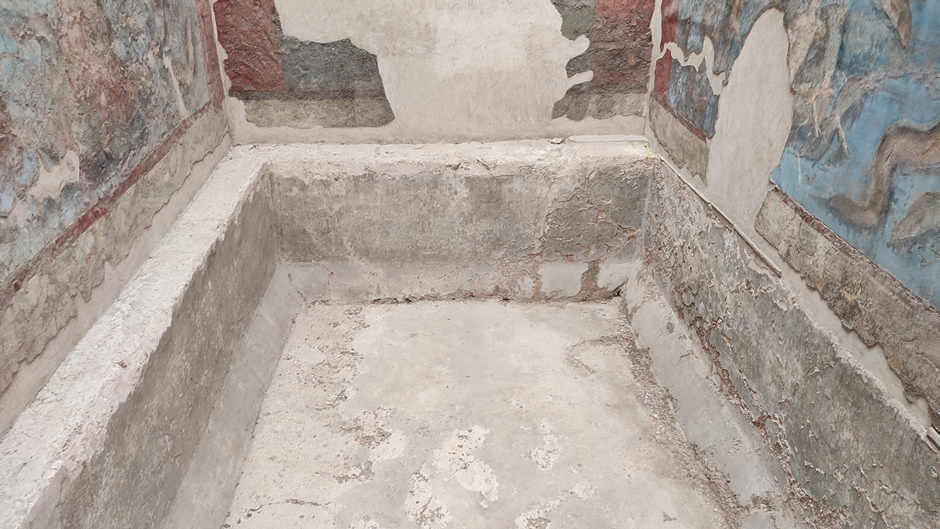
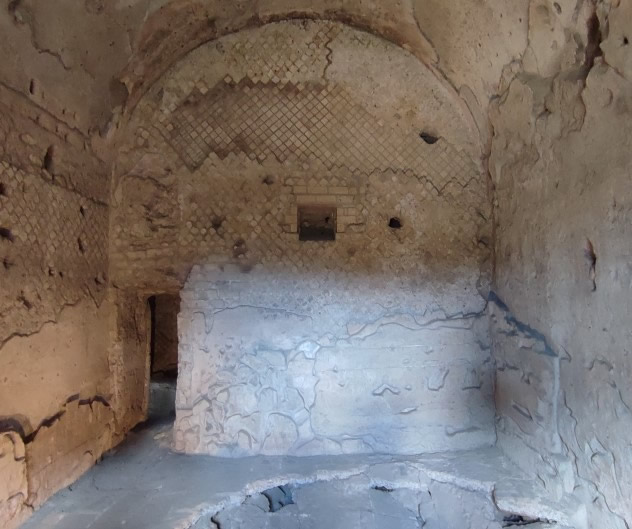 |
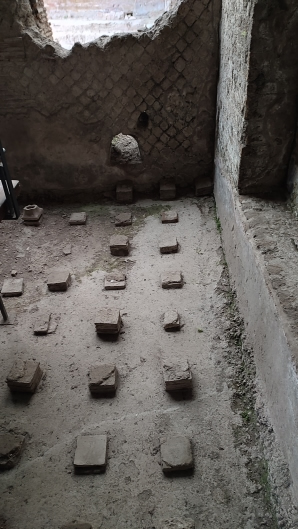 |
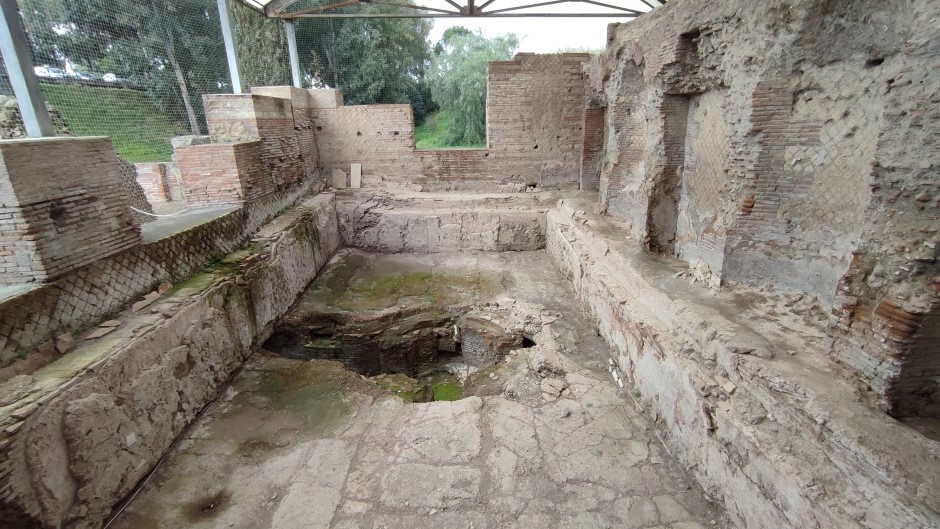
Porta Marina e cinta muraria. The Porta Marina, an impressive city gate, provided access to the sea. The surrounding walls, dating back to the 6th century BC, were once a defensive structure but later lost this role as Pompeii became a Roman colony:


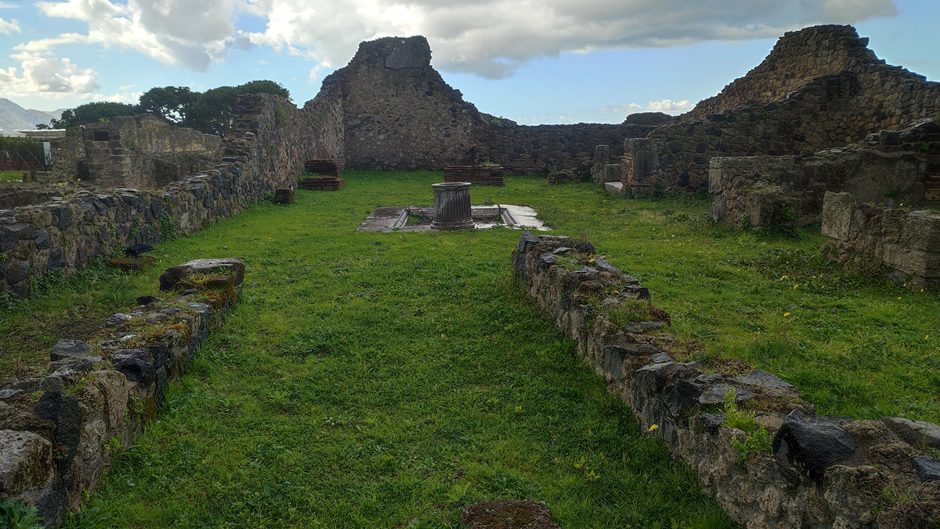
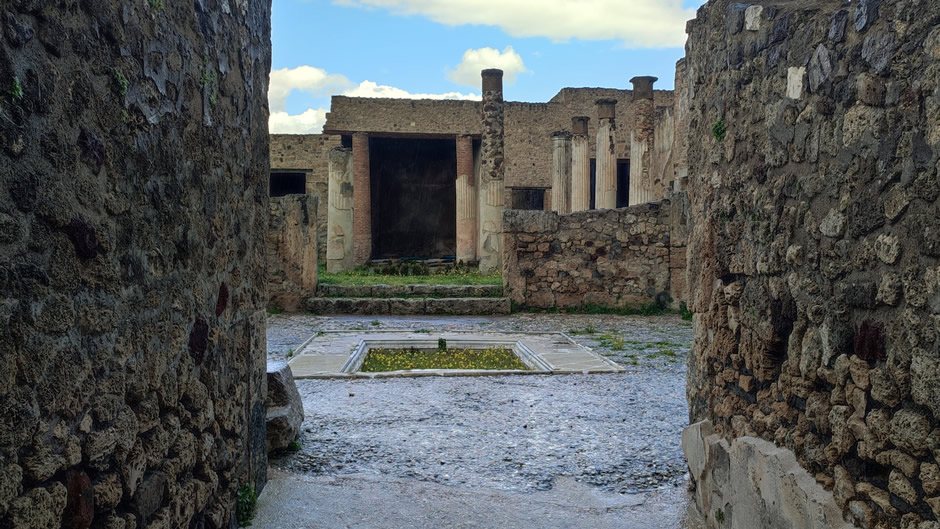
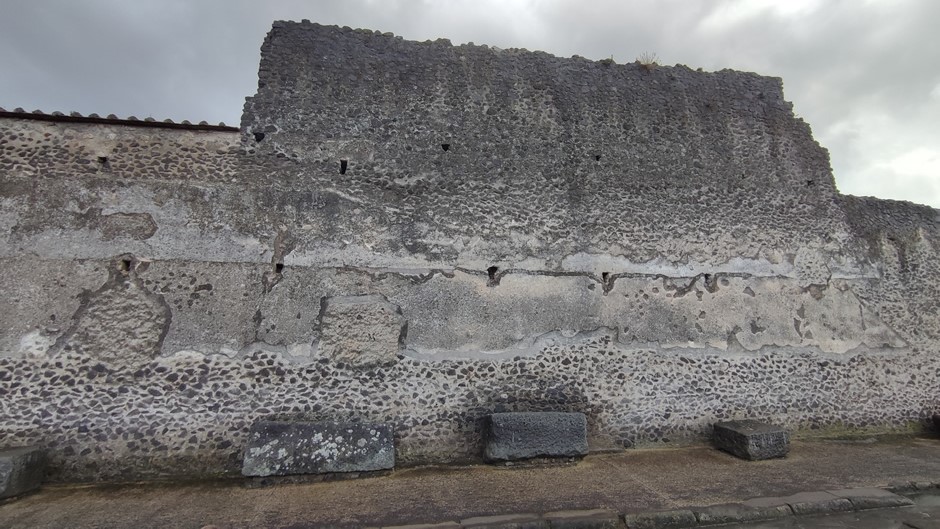
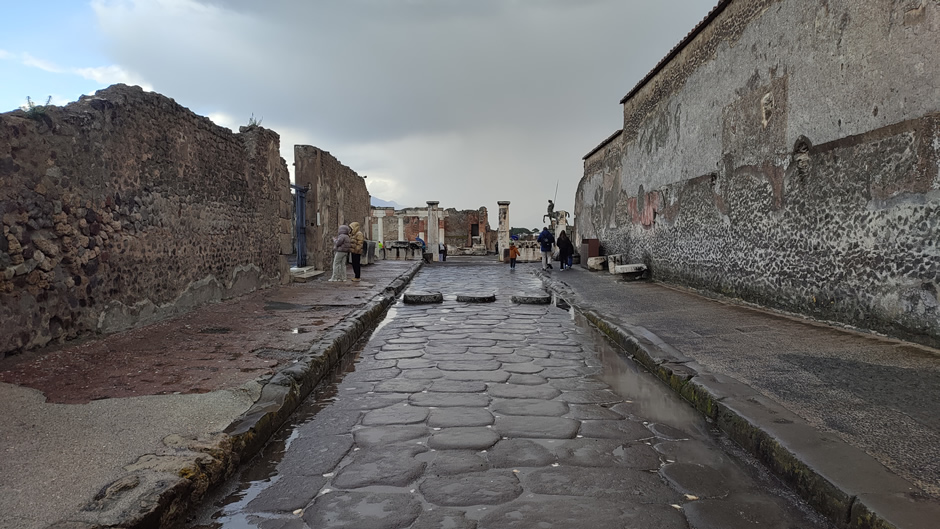
Basilica. Dating back to 120 BC, the Basilica was a grand public building in the Forum used for business and administration of justice. It was one of the oldest of its kind in the Roman world, showcasing rich decorations and an imposing structure:


Santuario di Apollo. One of the oldest worship sites in Pompeii, this sanctuary honored Apollo and featured a temple surrounded by a portico and an altar at its center. It connected to the Forum, serving as a venue for games and festivities:


Foro. The Civil Forum was the heart of Pompeii, surrounded by important public buildings and temples. It was a bustling center for civic, commercial, political, and religious activities:



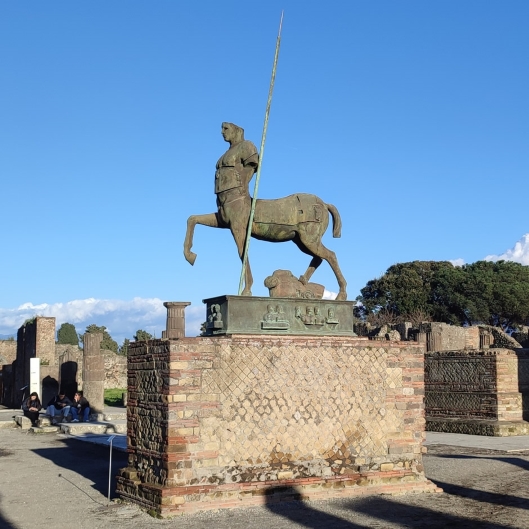
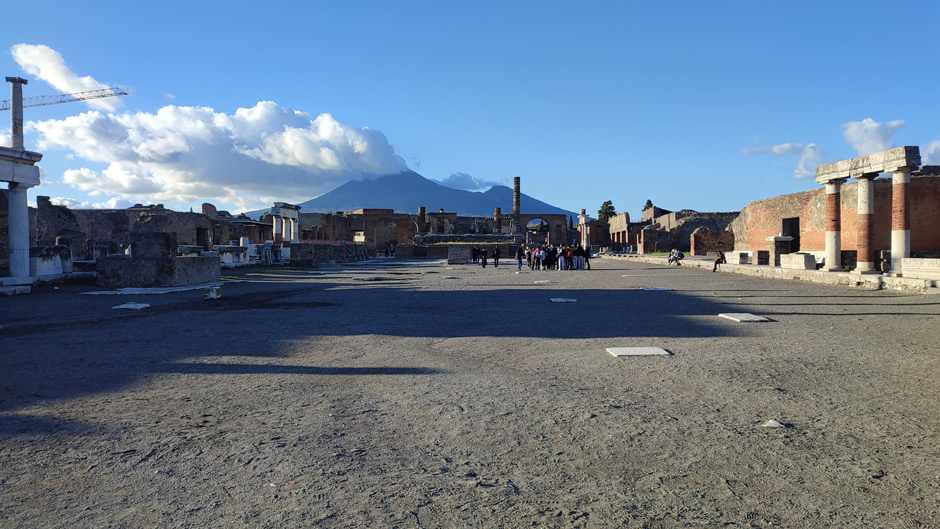
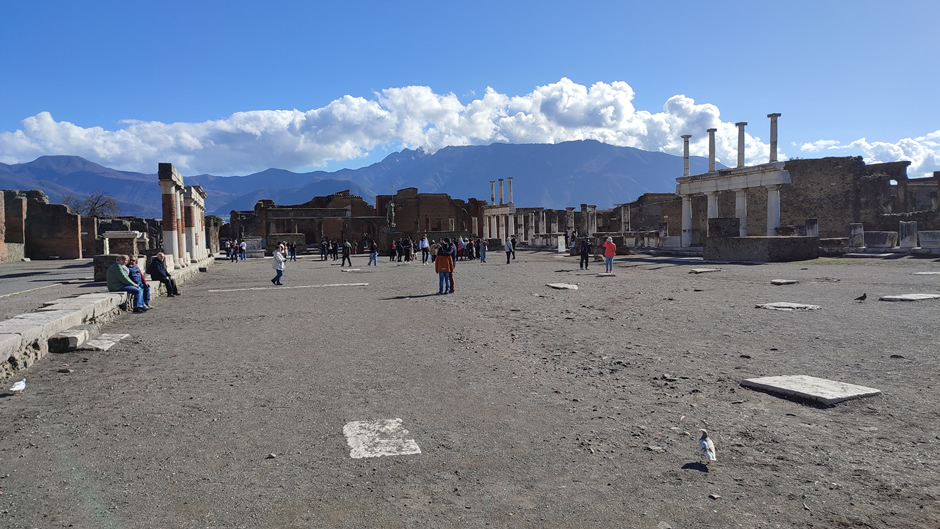
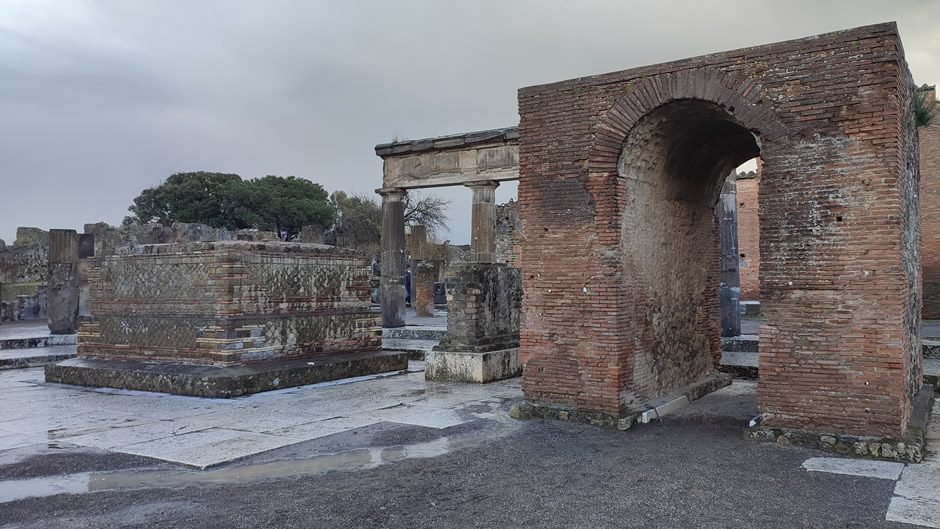
Portico della Concordia Augusta (Edificio di Eumachia). Built by Eumachia, a priestess of Venus, this building was dedicated to the emperor's cult. It featured statues of prominent Pompeians and a rich marble frame, which was mistakenly relocated from the adjacent Temple of Genius Augusti:


Tempio del Genius Augusti (Tempio di Vespasiano). Erected by Mamia, a priestess of Ceres and the Genius of Augustus, this temple had a small courtyard, an altar, and a temple with four columns. Its beautiful marble decoration was inspired by the Ara Pacis in Rome:

Santuario del Lari Pubblici. This sanctuary was likely built after the earthquake of 62 AD to appease the divine. It was dedicated to the Lares, the protective deities of Pompeii, and featured a large open space on the Forum with a central altar for sacrifices:

Tempio di Giove (Temple of Jupiter). Dominating the north side of the Forum, this grand temple, originally dedicated to Jupiter, was later devoted to the Capitoline Triad - Jupiter, Juno, and Minerva. It showcases the religious transformation following Pompeii's absorption into the Roman realm:

Macellum (Market). Situated on the Forum, the Macellum served as Pompeii's provision market. This space, once bustling with vendors and shoppers, reveals the commercial life of the city, with remnants of food stalls and frescoes depicting daily activities:



Archi onorari (Honorary Arches). These brick and marble arches, once located at the northern end of the Forum, celebrated the imperial family. Although only traces remain, they once honoured figures like Emperor Caligula and Drusus, son of Emperor Tiberius:

Located behind the Forum (just beyond the honorary arch shown above), the Visitor’s Café offers modern-day visitors refreshments amidst the ancient ruins, providing a place to rest and reflect on the experiences of Pompeii.
Terme del Foro (Forum Baths). The largest baths in ancient Pompeii, these were a complex of rooms for bathing and socializing, featuring intricate decorations and a sophisticated heating system. They highlight the importance of hygiene and leisure in Roman culture:



Casa del Poeta Tragico (House of the Tragic Poet). This house is renowned for its intricate mosaics and frescoes depicting Greek mythology. The quality of its decorations suggests the affluence of its inhabitants, who likely perished in the eruption. This atrium house is famous for the mosaic that reads CAVE CANEM ("beware of the dog"), at the main entrance. Although the house is not accessible to general visitors, the Cave Canem mosaic at the entrance can be viewed through a protective glass screen:

Thermopolium. The ancient equivalent of a fast-food restaurant, these establishments catered to those without cooking facilities. With counters decorated with frescoes, they were central to the street life and social gatherings in Pompeii. The photos shown below of Thermopolium are followed by a few general shots, before we move on to Casa dei Vettii (House of the Vettii - and if you are offended by images of Roman art containing genitalia, perhaps now is the time to stop scrolling through this webpage!):

 |
 |

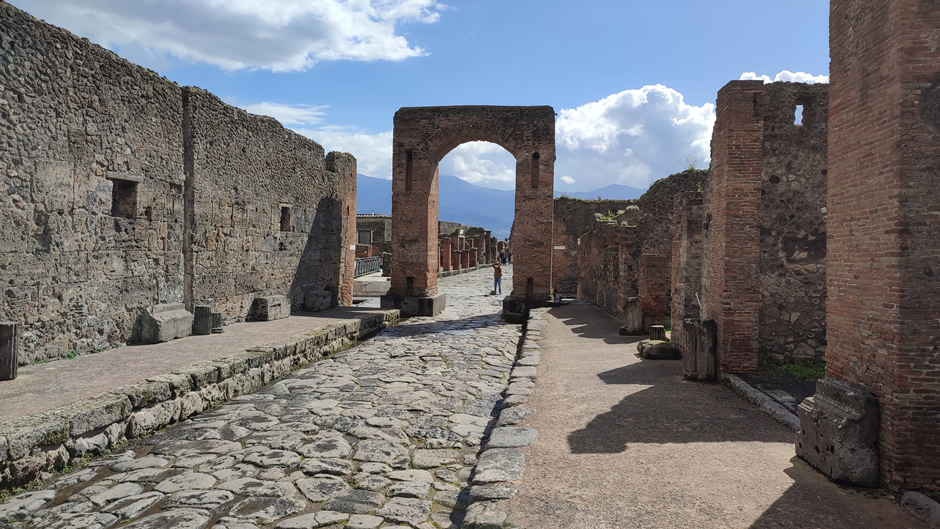
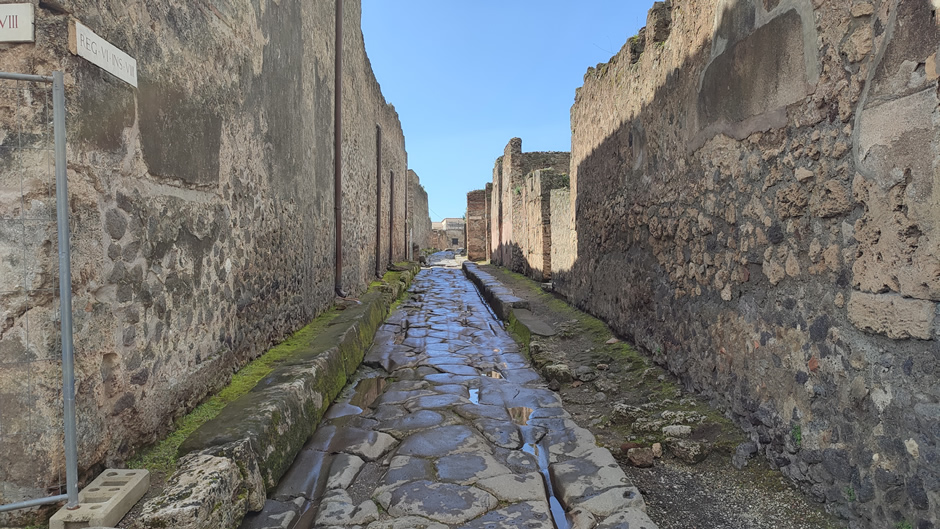
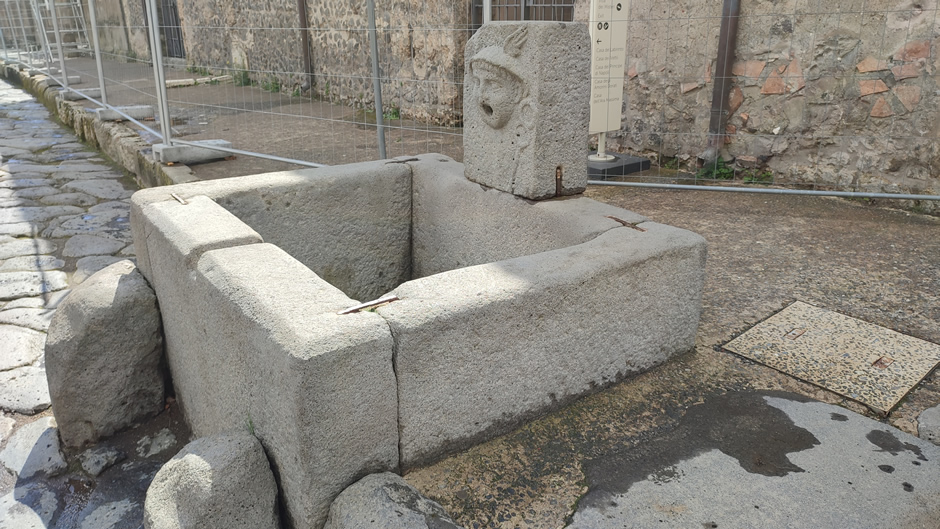
Casa dei Vettii. Owned by two successful freedmen, this house is famous for its well-preserved frescoes in the Pompeiian Fourth Style. It's a testament to the wealth and social status that freedmen could achieve in Roman society:
 |
 |

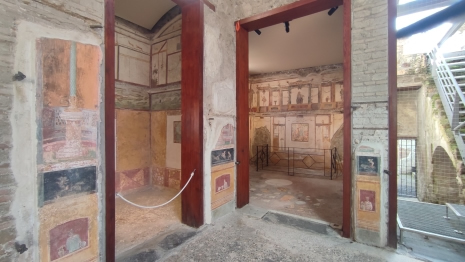 |
 |
|
 |
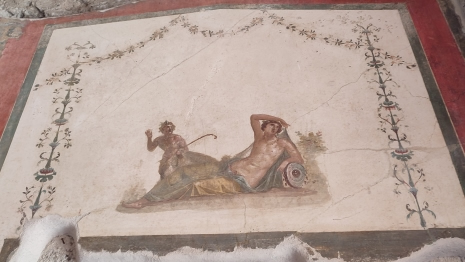 |
|
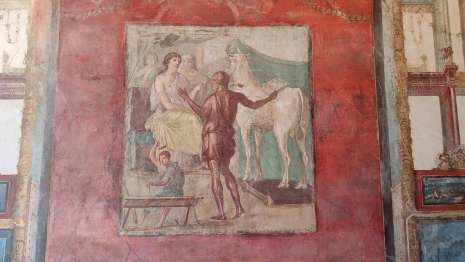 |
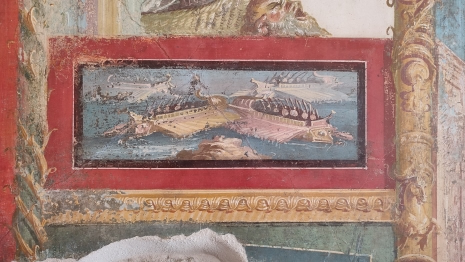 |
|
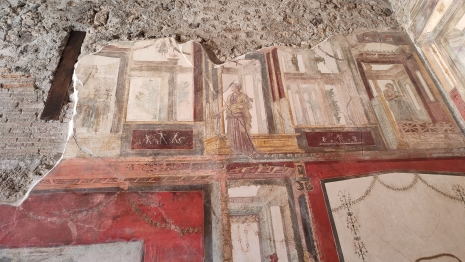 |
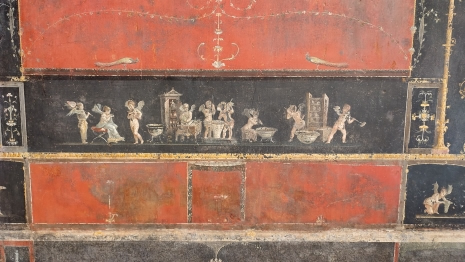 |
|
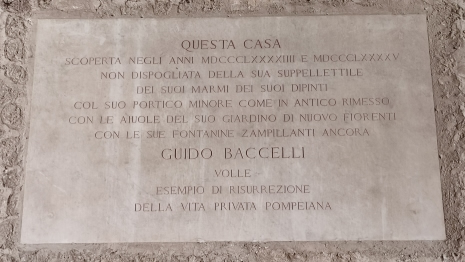 |
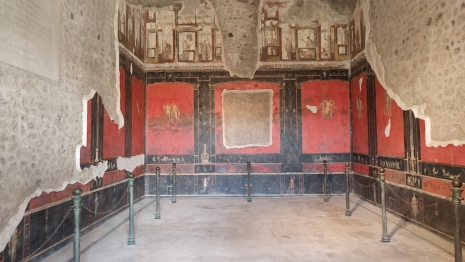 |
|
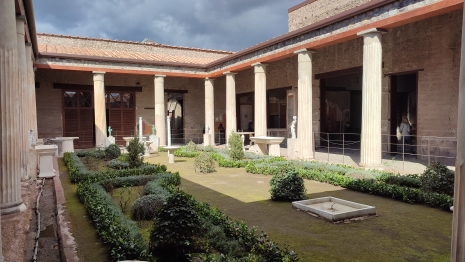 |
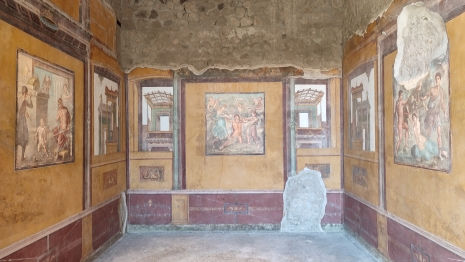 |
Casa degli Amorini Dorati (House of the Golden Cupids). An elegant imperial-era residence, it's known for its luxurious decorations and artworks. The house features a unique garden and was possibly owned by a priest involved in the cult of Egyptian deities:



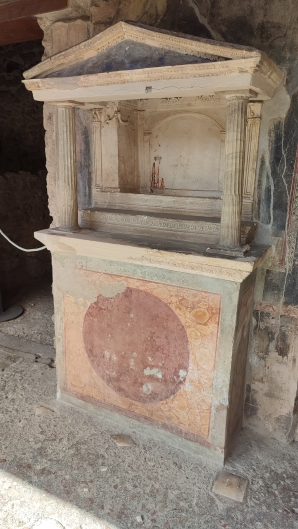 |
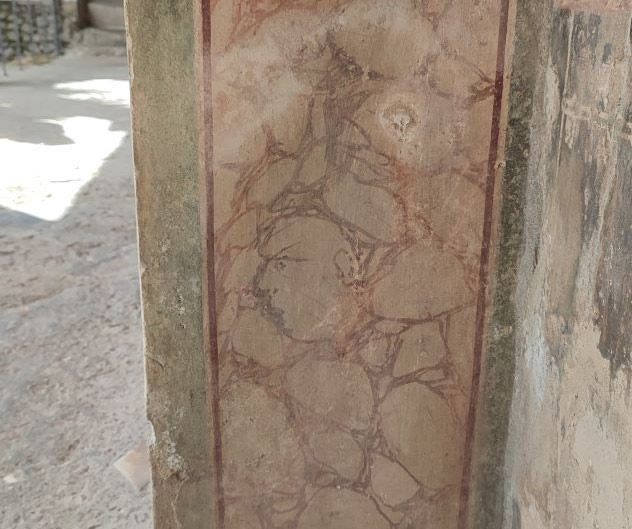 |
Exiting The House of the Golden Cupids on the eastern side, it is possible to see the boundary between what has been excavated at the site and the higher ground covering parts of the city yet to be revealed. While much has been uncovered, approximately one-third of Pompeii remains unexplored. The process of excavating Pompeii is slow and meticulous due to the substantial layers of pumice and ash that must be carefully removed. It is estimated that these excavations will continue for many generations to come:


Bakeries in Pompeii. The bakeries of Pompeii are remarkable for their advanced design, featuring mills, ovens, and evidence of large-scale bread production. About 35 bakeries have been identified, highlighting the importance of bread in Roman daily life:

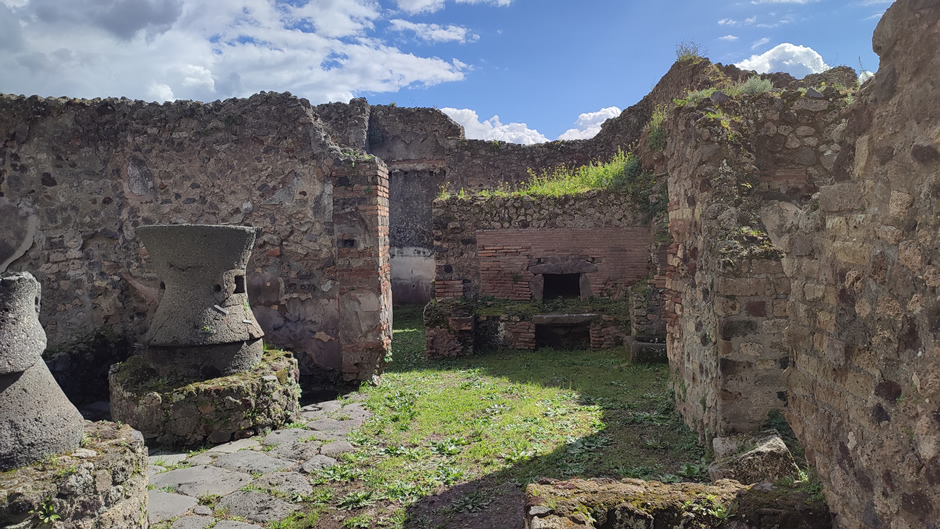
Casa di Cecilio Giocondo (House of Lucius Caecilius Iucundus).
Although his house is not the most noted site in Pompeii, Lucius
Caecilius Iucundus may be familiar to anybody from the UK who has
studied Latin at school. The Pompeian banker Caecilius takes on a role
as the central character in the popular Cambridge Latin Course, with the
character being based on Iucundus and his family. Through the
fictionalized account of Caecilius, students learn about Roman life,
culture, and language. First published in 1970, the Cambridge Latin
Course is the most-used Latin course in the UK for secondary school
pupils, being used by 85% of Latin-teaching schools.
The House of Lucius Caecilius Iucundus itself is renowned for its
frescoes and other architectural features. In 1875, a significant
discovery was made inside, a trove of wax tablets containing records of
Iucundus’ banking operations. These tablets provided scholars with
valuable insights into financial transactions and daily life in ancient
Pompeii.


Terme Stabiane (the Stabian Baths). The Stabian Baths, one of the oldest known Roman bathing complexes, showcase the ingenuity of Roman engineering. With separate sections for men and women, these baths provided a space for socializing and relaxation:


Teatro Grande. A grand theatre built into a natural hill, the Teatro Grande is a testament to the architectural ingenuity of the ancient Romans. Built in the 2nd century BC, it exploited the natural slope of a hill for its construction, providing seating for approximately 5,000 spectators. It hosted dramatic performances and is a testament to the cultural life of Pompeii. The theatre underwent significant Roman-style renovations, including the addition of a velarium to shield spectators from the sun, and the numbering of seats for organization. The Teatro Grande was not only a venue for performances of Greek-Roman comedies and tragedies but also a reflection of the social hierarchy of the time, with seating divided according to class. Excavated in the 18th century, it was one of the first large public buildings to be freed from the volcanic deposits of the eruption that buried Pompeii:


More Pompeii
It was at this point, the walking tour ended, and so it was time for a bite to eat (at the busy but off-season Visitor’s Café situated within the site), before exploring the Antiquarium di Pompei (Archaeological Museum) and more of the ancient town that time would permit.

Above: Santuario di Venere (Sanctuary of Venus). The Sanctuary of Venus in Pompeii, dedicated to the goddess of love and beauty, is situated on an artificial terrace and offers stunning views of the Gulf of Naples. Destroyed by earthquakes and later partially reconstructed, it stands as a testament to ancient worship and architectural ingenuity. Notably, a large gold lamp from Emperor Nero was discovered here.
Antiquarium di Pompei (Archaeological Museum). The Antiquarium di Pompei, established between 1873 and 1874 by Giuseppe Fiorelli, stands as a testament to the rich history and daily life of ancient Pompeii. Located beneath the terrace of the Temple of Venus, this museum overlooks the Porta Marina and houses a selection of artifacts that exemplify the everyday life of the city before it was buried by the catastrophic eruption of Mount Vesuvius in 79 AD. Amedeo Maiuri, a prominent figure in the history of the Antiquarium, expanded the museum in 1926. Despite suffering damage during World War II and the 1980 earthquake, the Antiquarium has been restored and reopened. The latest inauguration in January 2021 introduced a new layout, making it a museum space dedicated to the permanent exhibition of artifacts that narrate Pompeii's story from the Samnite era (4th century BC) to the eruption.

Narrating the history of Pompeii from the Samnite era (4th century BC) until the tragic eruption, the Antiquarium offers insights into the daily lives of Pompeii’s inhabitants. Notable displays include the frescoes from the House of the Golden Bracelet, the Moregine Silver Treasure, and the triclinium of the House of Menander. Recent excavations have added to this collection, such as the amulet treasure from the House with the Garden and the casts of victims from the Civita Giuliana villa. The Antiquarium also embraces modern technology with digital aids like a “web-bot” and audio narration, enhancing the visitor experience and providing a comprehensive understanding of Pompeii's archaeological park.

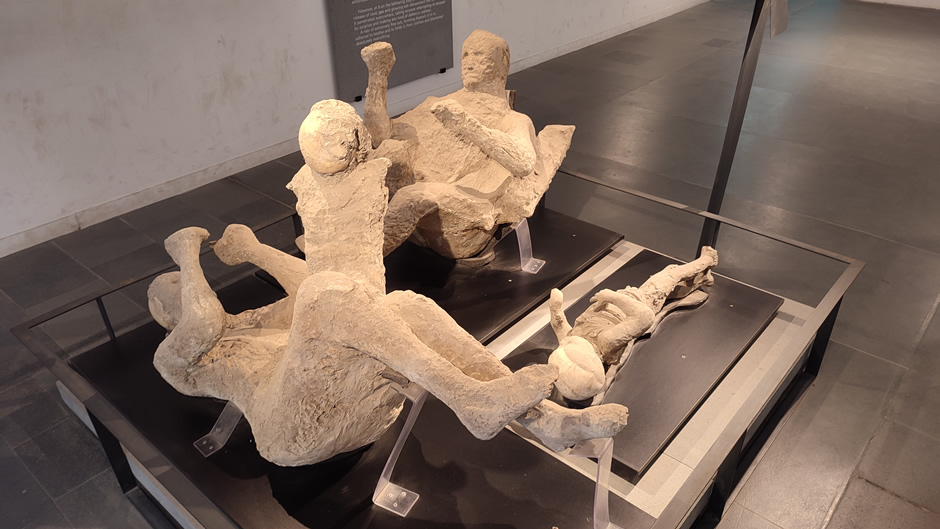
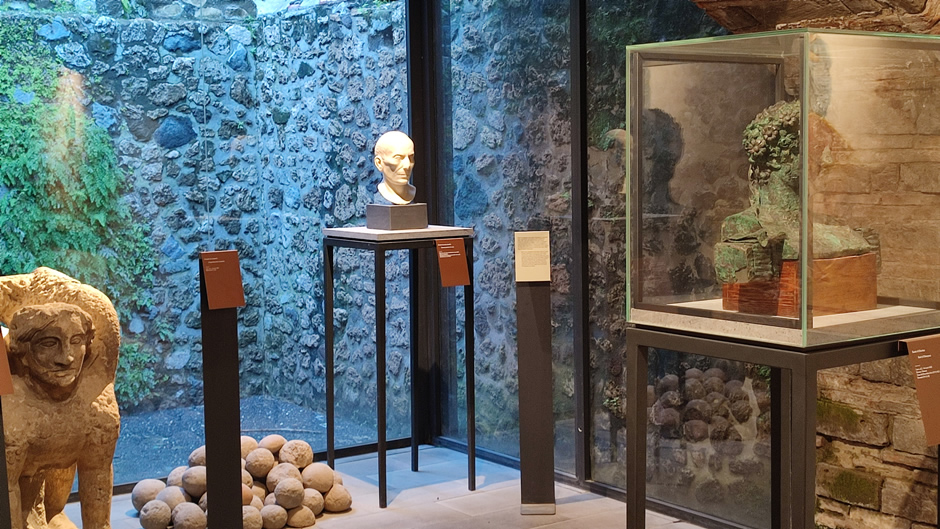
A few general photos follow, taken whilst walking from the Antiquarium di Pompei to the Anfiteatro (Amphitheatre):



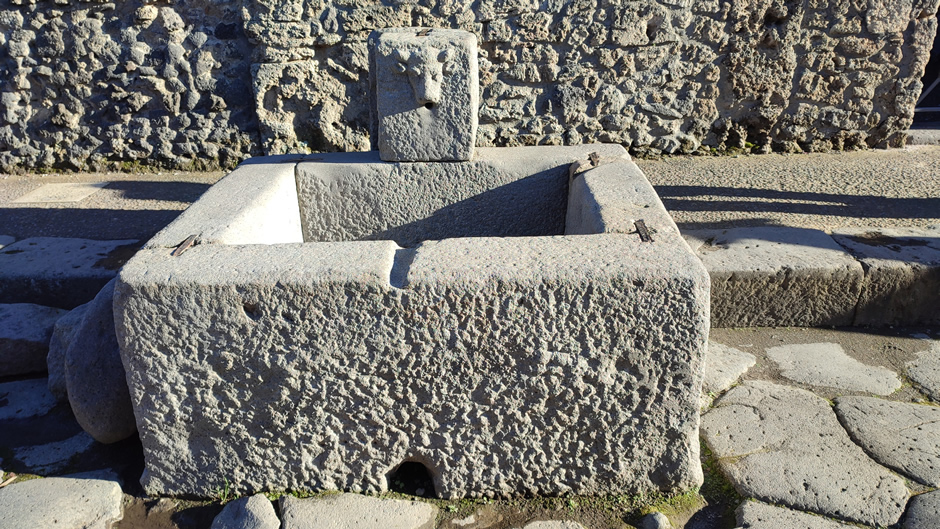
Anfiteatro (Amphitheatre). The Amphitheatre of Pompeii, constructed around 70 BC, is one of the oldest surviving Roman amphitheatres. This ancient structure could accommodate up to 20,000 spectators, reflecting its significance in Roman society and the Roman love for games and public spectacles. It was buried under the ash of Mount Vesuvius in 79 AD, along with the city. The site offers a unique glimpse into Roman entertainment and architecture, with its design lacking underground areas for gladiators, a feature common in later amphitheatres. Underneath the seating structure, either side of the main entrance (and at the time of the visit) can be seen a unique tribute to Pink Floyd, one of the most influential rock bands of all time. It not only celebrates the band's legendary 1971 performance here at the amphitheatre, but also provides a rare glimpse into the behind-the-scenes moments and the making of their groundbreaking album The Dark Side of the Moon. In 2016, Pink Floyd’s David Gilmour returned here to record his live album and film Live at Pompeii, which in turn was part of a world tour to promote his album Rattle That Lock:


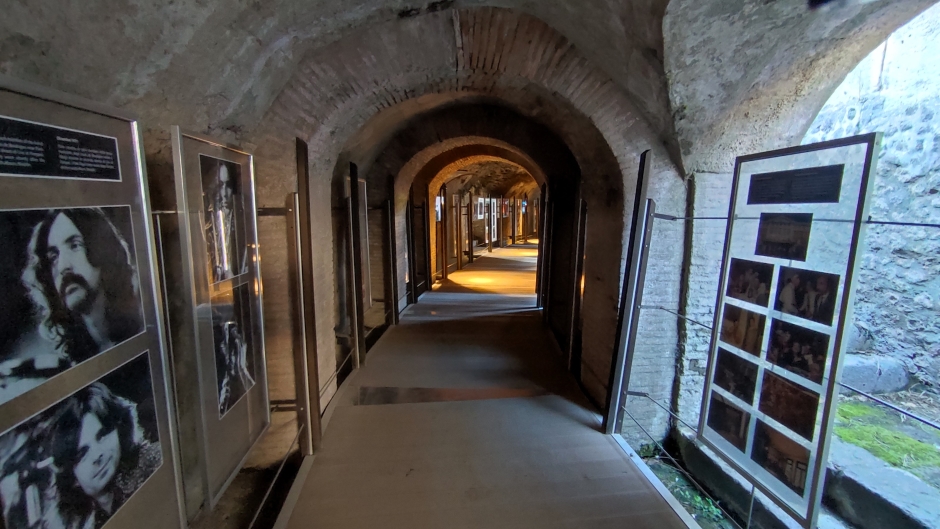
Palestra Grande. The Palestra Grande was a large open-air square surrounded by porticoes, serving as a space for physical training. It highlights the Roman emphasis on fitness and athleticism:


Casina dell’Aquila. And finally, Casina dell'Aquila is a notable non-Roman structure situated on the southern hill of Civita, overlooking the city ruins. It was likely constructed between the late 18th and early 19th centuries for archaeologists, during the period when Pompeii was being rediscovered and excavated. The building stands out against the backdrop of the Vesuvian landscape and serves as a prominent feature above the buried ruins. Notably, the Casina dell'Aquila was used as a vantage point for viewing the excavation sites, and today, equally offers visitors a panoramic view of the uncovered city:


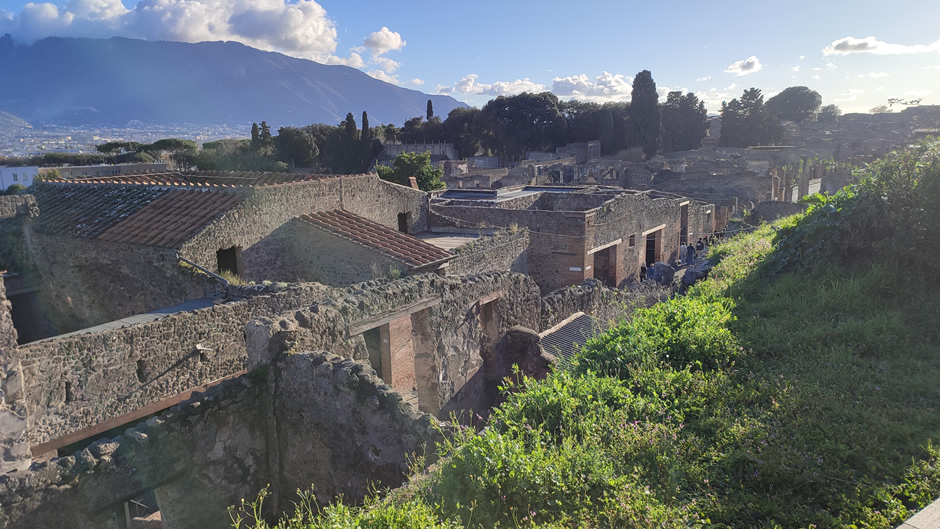
Pompeii, frozen in time, remains one of the largest and most valuable archaeological sites in the Roman world. Its mysteries continue to unfold as excavations continue.

Note: On this website, there is another webpage dedicated to an earlier visit to Pompeii that took place in 1992. To view this page, please click on the photo below:
Next Page (4):
Capri
Previous Page
(2): Amalfi Coast
Page 1: Naples Cathedral and the Accommodation near
Sorrento
Page 5: National Archaeological Museum of Naples
Back to Top
